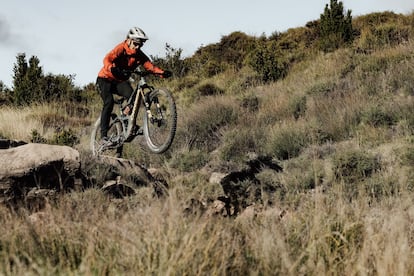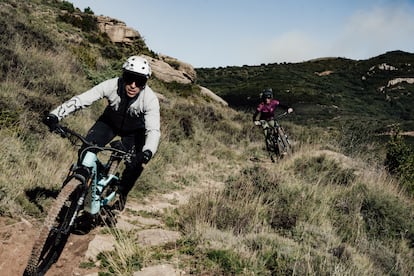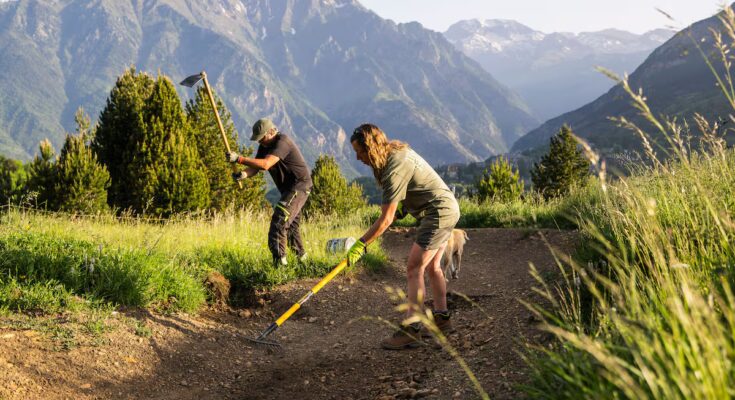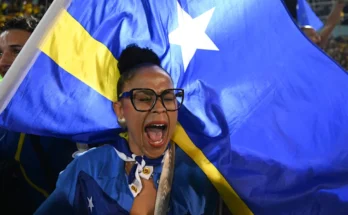The mountain paths are lifelines, arteries through which happy, tired, fast, absorbed women and men circulate, trying to connect the starting point with the arrival point. Previously they were connections between villages, hunting trails, smuggling opportunities or refuge for shepherds and their flocks. Today free time absorbs almost everything and without paths there would be no hikers, cyclists or mountain runners. Paths and roads observe their own life cycles: now they are eroded by frequent human traffic and then they disappear into oblivion, swallowed up by indifference and the pursuit of the undergrowth. Work is needed to restore them, including to create new avenues of expression. There are very few people in Spain who dedicate themselves to their care, and most come from the world of mountain biking, always eager to get away from the boring forest paths to seek a more aesthetic and playful playground.
Ángel Cheliz is largely responsible for the so-called “miracle of Aínsa”, a reference town in the Sobrarbe region (Aragon), where Zona Cero was born in 2011 by “chance”. He and his friends were looking for new routes for their mountain bikes: “In this region there is no gold, but paths. We had already ridden the clean ones and were looking for more. So we started cleaning the paths for our own use and enjoyment. Little by little people from outside arrived, they liked our paths and an expectation was created.” His initiative immediately went viral. Suddenly, in one of the most uninhabited regions of Spain (in 1960 Sobrarbe had just over 23,000 inhabitants and in 1980, when it hit rock bottom, it had 6,000. Now it has 7,700, but 40% of the centers that existed in the mid-20th century are depopulated) Belgians, Dutch, English, Americans, Australians… eager to try the their full-suspension bikes on natural paths and infinite routes close to each other recovered in a majestic environment.
“A very important peculiarity is that the paths we cleaned already existed, they were vestiges of the past, but they were used decades ago connecting villages now abandoned because they invited them emigrate with hydraulic and national reforestation policies. When the inhabitants left, they planted pine trees. All this abandonment meant the end of the paths they used”, explains Cheliz. But the trace of these paths was in the national photographic archive: “In the 1950s, the United States wanted to build military bases in Spain and Franco asked them to photograph the country from the air. It was the famous aerial photographic flight of ’56, with cutting-edge means for the times: perhaps we are the country in Europe with the best vintage photos of our territory. Back then Spain was an agricultural country, people lived off the mountains and fields and everything was like a garden. The streets can be seen perfectly, so we dig a lot into the old archive,” he adds.
Zona Cero has 1,200 kilometers of marked trails. A ferocity that costs a lot to maintain: in the center there are two permanent people a year who clean the streets, five in winter… and then there is the volunteering. “Those people are paid by Zona Cero by looking for subsidies even under the rocks, even if Orbea (a cooperative company dedicated to the production of bicycles) helps us a lot”. Cheliz highlights the difference between reclaiming old trails and creating them, either by hand or with heavy machinery. “In Canada, which is the mecca of mountain biking (Btt), the vast majority of trails have been created expressly for use by cyclists and hikers, because they do not have an old network to travel on. Everything was created based on machinery and human labor. They have no soul, unlike the streets of Sobrarbe which have been traveled for decades on foot, with mules, with oxen…”
Many years of unpaid work have reawakened in Cheliz the passion to save the “old paths” of his ancestors: “My grandfather used to travel these paths with his donkey. Now we also restore the old hermitages from the 11th century so that cyclists can admire them,” he smiles. His passion leads him to work 1,000 hours a year for free and he only asks that, when he leaves, someone takes over.
Carlos Cuezva of La Rioja is a leading designer of downhill mountain bike trails with heavy machinery, his only occupation for two years. He met the Englishman Mark McClure of the Trailtools company, a point of reference in Europe, and applied his knowledge in Spain, putting it at the service of municipalities located in rural areas, threatened by oblivion, but which have European funds. “In Spain there is a great deal of ignorance on the part of institutions and users about what it means to create routes for mountain biking. Sometimes, they ask us to create trails in inappropriate places. Our philosophy is to create fewer kilometers of trails, but which are of quality. That is, to create routes that people want to repeat and, if possible, that don’t cost too much to climb and that you can do several descents from the same place. In the Pyrenees, for example, it happens that the descents are very far apart. Yes, or they require you to pedal for many meters of altitude difference, which is not within everyone’s reach. We see that there is a need for a more accessible playground for all the public, especially for those who want to start mountain biking,” says Cuezva.

Creating one or more descent itineraries in the middle of a forest requires a tailor-made project: “Let’s start by planning where pathwe clean the forest corridor, that is, where the path will go, we draw its average slope to give difficulty to the path, and if trees or vegetation need to be removed, they are removed, cut, and collection pits are created where the layer of vegetation that we do not use is also placed. And with the earth that we removed from the hole we build the path and, finally, we revegetate the slopes. The kilometer costs 30,000 euros, with jumps, banks etc. A good day’s work is 40 meters of path built. The difficulties are like on the ski slopes: green, blue, red and black and even double black”, he adds.
Between the restoration of the old paths and the creation of new ones with the backhoe, a profile emerges trail builder which defends manual, slow, methodical and small-scale work. This profile is not abundant, but it is growing. “Right now, the great national reference is Dani Terrise, who with five other friends has created almost 100 kilometers of cycle paths in Tremp (Lleida) over the last 10 years,” explains Javi García, founder of Insólito Proyectos, a consultancy company that develops tourism ideas and projects, many of which are based on bicycles. García is also one of the great recoverers of high mountain paths in the Pyrenees and assures that the sector is experiencing a moment of transition: “The group is in a moment of intense debate, which we discussed at the European summit in Boltaña. We see that it is necessary to create infrastructure, but the cost of construction is very high and it is necessary to keep the paths in good condition and clean. A lot of manpower is needed and it is necessary to find the necessary financing”, he analyzes before asking for a plan on a national scale. “The projects must be of a national format, and not even regional, because this way we have not achieved much. We need a strategic plan for mountain biking in rural areas, and this must be understood in Madrid. And to do this, our sector must organize itself: we need money, forestry personnel, manpower because the money comes from Europe but not in a structured way. Creating something like a Spanish network of destinations could work. And for this purpose we must obtain structural support, not just punctual”, he proposes.

Spain is an idyllic country for mountain biking, it has varied and rich terrain, suitable climate, gastronomy, history and is a brilliant alternative to what other destinations offer. “If we fail to focus all our efforts on creating, rehabilitating and maintaining well-used trails and mountain bike centers, we will miss a great opportunity to generate jobs and services,” says Javi García.



